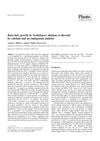Extracellular ATP in Plants. Visualization, Localization, and Analysis of Physiological Significance in Growth and Signaling
September 2006
in “
PLANT PHYSIOLOGY
”
TLDR Extracellular ATP is crucial for plant root growth and signaling.
The study explored the presence and role of extracellular ATP (eATP) in plants, specifically in Medicago truncatula. Researchers used a novel reporter system combining a cellulose-binding domain peptide with luciferase to visualize eATP in plant roots. They found that eATP was present in interstitial spaces between epidermal cells and was associated with regions of active growth and cell expansion. The release of ATP was shown to be a calcium-dependent process, potentially occurring through vesicular fusion, which is crucial for root hair growth. Reactive oxygen species (ROS) activity, essential for root hair growth, was influenced by cytoplasmic calcium levels and eATP. Exogenous ATP and chitin increased ROS activity, while potato apyrase decreased it, indicating a close association between eATP release, calcium gradients, and ROS activity.
